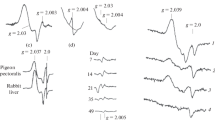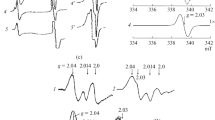Abstract
Dinitrosyl iron complexes (DNIC) with thiolate ligands and S-nitrosothiols, which are NO and NO+ donors, share the earlier demonstrated ability of nitrite for inhibition of catalase. The efficiency of inhibition sharply (by several orders in concentration of these agents) increases in the presence of chloride, bromide, and thiocyanate. The nitro compounds tested—nitroarginine, nitroglycerol, nitrophenol, and furazolidone—gained the same inhibition ability after incubation with ferrous ions and thiols. This is probably the result of their transformation into DNIC. None of these substances lost the inhibitory effect in the presence of the well known NO scavenger oxyhemoglobin. This fact suggests that NO+ ions rather than neutral NO molecules are responsible for the enzyme inactivation due to nitrosation of its structures. The enhancement of catalase inhibition in the presence of halide ions and thiocyanate might be caused by nitrosyl halide formation. The latter protected nitrosonium ions against hydrolysis, thereby ensuring their transfer to the targets in enzyme molecules. The addition of oxyhemoglobin plus iron chelator o-phenanthroline destroying DNIC sharply attenuated the inhibitory effect of DNIC on catalase. o-Phenanthroline added alone did not influence this effect. Oxyhemoglobin is suggested to scavenge nitrosonium ions released from decomposing DNIC, thereby preventing catalase nitrosation. The mixture of oxyhemoglobin and o-phenanthroline did not affect the inhibitory action of nitrite or S-nitrosothiols on catalase.
Similar content being viewed by others
Abbreviations
- Cys-NO:
-
S-nitrosocysteine
- DNIC-GS:
-
dinitrosyl iron complex with glutathione
- GSH:
-
glutathione
- GS-NO:
-
S-nitrosoglutathione
- HbO2 :
-
oxyhemoglobin
- p-NP:
-
p-nitrophenol
- o-Ph:
-
o-phenanthroline
References
Cohen, G., Martinez, M., and Hochstein, P. (1964) Biochemistry, 3, 901–903.
Nicholls, P. (1965) Biochim. Biophys. Acta, 99, 286–297.
Young, L., and Siegel, L. (1988) Biochemistry, 27, 2790–2800.
Titov, V. (2006) Current Enzyme Inhibition, 2, 1–17.
Titov, V. Yu., and Petrenko, Yu. M. (2003) Biochemistry (Moscow), 68, 627–633.
Brown, G. (1995) Eur. J. Biochem., 232, 188–191.
Licht, W., Tannenbaum, S., and Deen, W. (1988) Carcinogenesis, 9, 365–372.
Licht, W., Fox, J., and Deen, W. (1988) Carcinogenesis, 9, 373–377.
Mirvish, S. (1975) Toxicol. Appl. Pharmacol., 31, 325–351.
Severina, I., Bussygina, O., Pyatakova, N., Malenkova, I., and Vanin, A. (2003) Nitric Oxide, 8, 155–163.
Balazy, M., Kaminski, P., Mao, K., Tan, J., and Wolin, M. (1998) J. Biol. Chem., 273, 32009–32015.
Titov, V. Yu., and Petrenko, Yu. M. (2005) Biochemistry (Moscow), 70, 473–483.
Titov, V., Vanin, A., Serezhenkov, V., and Petrenko, Yu. (2003) Probl. Ecol. Secur. Agric., 6, 50–65.
Kurbanov, I. S., Mordvintsev, P. I., Aliev, D. I., and Vanin, A. F. (1989) Vopr. Med. Khim., 35, 87–91.
Vanin, A., Muller, B., Alencar, J., Lobysheva, I., Nepveu, F., and Stoclet, J.-C. (2002) Nitric Oxide, 7, 194–209.
Vanin, A. F., Papina, A. A., Serezhenkov, V. A., and Koppenol, W. H. (2004) Nitric Oxide, 10, 60–73.
Vanin, A. F. (1993) Biofizika, 38, 751–761.
Boese, M., Mordvintcev, P. I., Vanin, A. F., Busse, R., and Mulsch, A. (1995) J. Biol. Chem., 270, 29244–29249.
Deisseroth, A., and Dounce, A. (1970) Physiol. Rev., 50, 319–375.
Author information
Authors and Affiliations
Corresponding author
Additional information
Original Russian Text © V. Yu. Titov, Yu. M. Petrenko, A. F. Vanin, 2008, published in Biokhimiya, 2008, Vol. 73, No. 1, pp. 113–118.
Rights and permissions
About this article
Cite this article
Titov, V.Y., Petrenko, Y.M. & Vanin, A.F. Mechanism of inhibition of catalase by nitro and nitroso compounds. Biochemistry Moscow 73, 92–96 (2008). https://doi.org/10.1134/S0006297908010148
Received:
Revised:
Published:
Issue Date:
DOI: https://doi.org/10.1134/S0006297908010148




